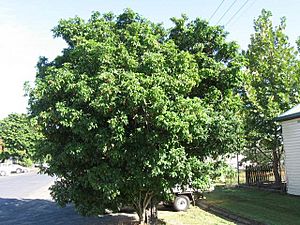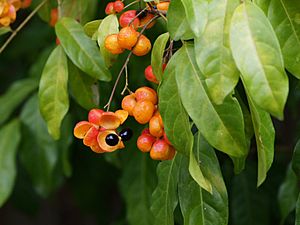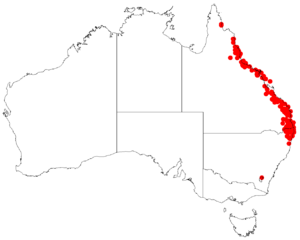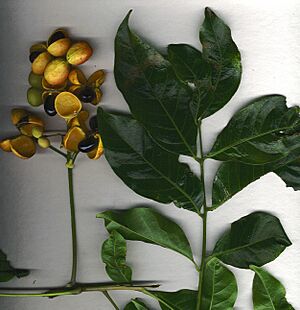Tulipwood facts for kids
Quick facts for kids Tulipwood |
|
|---|---|
 |
|
| habit (above), fruits and leaves (below) | |
 |
|
| Scientific classification | |
| Genus: |
Harpullia
|
| Species: |
pendula
|
 |
|
| Occurrence data from AVH | |
The Tulipwood (scientific name: Harpullia pendula) is a beautiful tree found in the rainforests of Australia. It's also called the Tulip Lancewood. This tree is usually small to medium-sized. People love it for its nice shape and pretty fruits, which makes it a popular tree to plant in gardens and along streets.
You can find Tulipwood growing naturally from the Bellinger River in northern New South Wales all the way up to Coen in tropical Queensland. It grows in different kinds of rainforests, often near streams or in drier rainforest areas. You might even see it planted as a street tree, like in St Ives, New South Wales.
Contents
What Does Tulipwood Look Like?
The Tulipwood is a medium-sized tree. It can grow up to 24 metres tall, with its trunk reaching about 60 centimetres across. However, when planted in towns, it's usually much smaller, often under 6 metres tall. It has a lovely, well-shaped top, called a crown.
The trunk of the tree is often uneven or grooved. Its bark is grey and looks a bit scaly.
Leaves of the Tulipwood
The leaves of the Tulipwood grow in a special way. They are called 'pinnate' leaves, which means they have several smaller leaflets arranged along a central stem, like a feather. These leaves grow one after another along the tree's branches.
- Each leaf has about three to eight leaflets.
- These leaflets are usually 5 to 12 centimetres long.
- They are also 2 to 5 centimetres wide.
- Their shape is like an oval, sometimes a narrow oval.
- Each leaflet has a short, blunt point at its tip.
- Often, the base of the leaflet is not perfectly even on both sides.
- You can clearly see the veins on both sides of the leaves.
- The main vein, called the midrib, sticks out a bit on both surfaces.
Tulipwood Flowers
Tulipwood trees produce their flowers from November to January. The flowers grow in clusters called panicles. They are a greenish-yellow colour and are about 15 millimetres wide.
Fruit and Reproduction
The fruits of the Tulipwood tree appear from August to October. They are shaped like a two-lobed capsule, almost like two small balloons joined together. These fruits can be bright yellow or red.
Inside the colourful fruit, you might find one or two shiny black or dark brown seeds. The bright and pretty fruit is one of the main reasons people love this tree for decoration.
To grow new Tulipwood trees, it's best to use fresh seeds. The seeds usually sprout quite easily. It can take anywhere from two weeks to two months for them to start growing.
Uses of Tulipwood
The Tulipwood is a very popular tree for planting in gardens and parks because it looks so nice. Its wood is also highly valued.
- The timber is excellent for making things on a lathe, like bowls or decorative items.
- It's also great for making fine furniture and cabinets.
- The wood has a fine grain, meaning it's very smooth.
- It is also tough, heavy, and lasts a long time.
See also
 In Spanish: Harpullia pendula para niños
In Spanish: Harpullia pendula para niños


